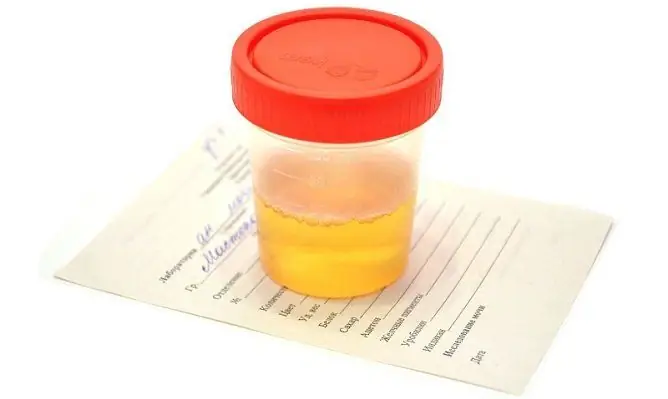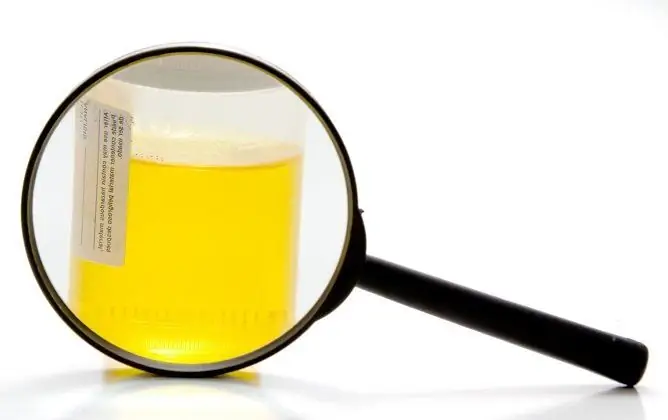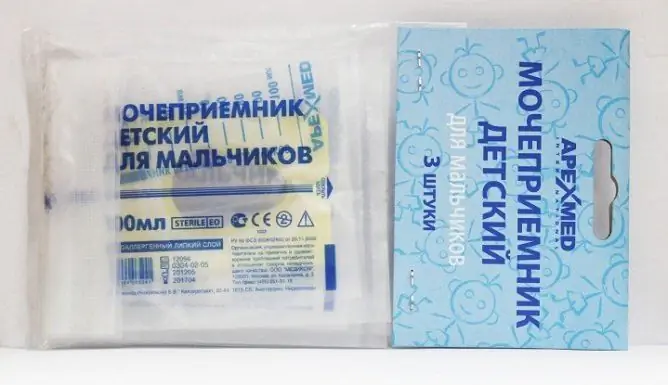- Author Rachel Wainwright [email protected].
- Public 2023-12-15 07:39.
- Last modified 2025-11-02 20:14.
How to collect urine from a baby girl: preparation, collection methods, their advantages and disadvantages
The content of the article:
- Errors while collecting urine from a baby girl
-
Urine collection methods
- Using a urine bag
- Using the package
- Using a jar
- Using a plate
- Using a rubber wheel
- Preparing for a urine test
How to collect urine from a baby girl? The complexity of the process is due to the fact that babies do not know how to control urination and inform adults about their need for it. There are different ways to facilitate this task.
In order to assess the growth and development of children in the first year of life, to timely identify possible diseases and pathologies in them, dispensary observation is carried out, including regular examination by a pediatrician, doctors of narrow specialization, as well as a number of laboratory tests and, above all, a general analysis of urine and blood.
Many children over 10-12 months of age already know how to communicate to their parents that they want to urinate. Therefore, it is quite simple to collect urine from them for analysis. But how to collect from a newborn or a girl at the age of 2-3 months? Here, parents may have certain difficulties. However, before talking about how to take a urine test, it is necessary to say a few words and how to do it is not recommended.

The easiest way is to collect urine from a nursing girl using a special urine bag
Errors while collecting urine from a baby girl
The most common mistakes made when collecting urine for research in babies in the first year of life are:
- Use for collection of urine diapers, diapers, cotton wool. Some parents put a piece of cotton wool between the large labia of their daughter, and then, after urinating, squeeze it into a jar. Others prefer to use a diaper or diaper for this purpose. In this case, tissue fibers, bacteria and other impurities inevitably enter the urine.
- Failure to comply with the rules of hygiene of the external genital organs. Immediately before collecting urine for analysis, the girl must be thoroughly washed. Otherwise, bacteria from the anus and perineal skin will also get into the sample.
- Late delivery of urine to the laboratory. Many parents at the doctor's office ask the question of whether it is possible to collect urine in the evening and deliver it to the laboratory the next day in the morning. You can't do that. With prolonged storage, various bacteria begin to actively multiply in the urine, its acid-base index changes.
All these errors reduce the reliability of the analysis results.
Urine collection methods
Using a urine bag
Now in any pharmacy you can buy special disposable urine bags for girls. Their main advantages:
- low price;
- sterility;
- preventing the spread of urine;
- the presence of a graduated scale in milliliters on the drive.
The disadvantage of a urine bag is only that its use requires a certain skill. Before putting it on, the girl should be thoroughly washed with clean warm water. Adhesive tape is removed from the urine bag and glued to the skin of the pubis, inner thighs. The girl should then be picked up and held upright to prevent possible urine leakage. If the baby is nervous and cannot urinate for a long time, you can give her a drink of water.
How much urine is needed for analysis, it is advisable to check with the doctor who gave the referral in advance. For a general analysis, at least 5 ml is required. After the required volume is collected, the urine bag is carefully removed. Then, after cutting the corner of the storage device, the urine is carefully poured into a clean, dry container and delivered to the laboratory.
If parents have never used a urine bag before and are afraid to use it incorrectly, you can watch a video that shows this process in detail.
Using the package
If you do not have a urine collection bag, a new plastic bag can be used to collect urine from infants. It is cut at the sides and worn like a diaper, with the ends tied at the thighs. The baby should be held in her arms in an upright position. After urinating, the bag is removed, the urine is poured into a clean jar.
This method is only suitable for babies in the first months of life. After six months, they become very active and easily tear off the bag or tear it off.

You can collect urine from a baby girl using a new plastic bag
Using a jar
If the doctor has ordered your daughter to have a urine test, it is advisable to purchase a sterile container in advance from the pharmacy. When, for one reason or another, this cannot be done, you can use an ordinary glass jar. Before use, it must be thoroughly washed in a hot baking soda solution, and then sterilized in a water bath. If the house has a dishwasher, the container can be washed and sterilized in it, choosing the mode with the highest temperature.
The girl, having previously washed, is placed on her back on a changing table covered with a waterproof diaper. The legs are pressed against the stomach and held in this position. As soon as the act of urination begins, a jar is brought to the genitals and urine is collected in it.
It is impossible to call this method convenient and comfortable for both the girl and her parents. Within a few minutes of being in a forced position, the baby begins to be capricious, show anxiety, and it becomes difficult to catch the right moment. Nevertheless, in some cases, this particular option is preferable - for example, this is the only way to take an average portion of urine from an infant for Nechiporenko analysis.
Using a plate
In children during the first months of life, during feeding or almost immediately after it, urination occurs. Knowing this physiological feature, you can collect urine from a baby girl using an ordinary plate. Before feeding, a thorough toilet of the child's external genital organs is carried out, after which a clean deep plate is placed under the buttocks, which is held in the correct position until the desired result is obtained.
Using a rubber wheel
The rubber circle is washed, wiped dry and wrapped in a diaper. A clean deep plate is placed in its center. The girl is washed and each of her legs is wrapped in a separate diaper. Then it is laid on a circle and covered with a diaper or blanket, depending on the air temperature in the room. Adults should definitely be near the baby and watch her.
This method of urine collection is most convenient for girls 1-3 months of age; its use in older children is difficult because of their considerable mobility and unwillingness to lie quietly in one position.
Preparing for a urine test
When preparing to collect urine for analysis, you should prepare everything you need in advance, and immediately in front of it, hold the toilet of the girl's external genital organs.
The day before the analysis, fish, tomatoes, all brightly colored foods (beets, carrots), citrus fruits should be excluded from the diet of a nursing mother and baby food. This limitation is explained by the fact that these products can change the color of urine or cause the appearance of salt crystals (phosphates, urates, oxalates) in it. A one-time detection of such deviations from the norm is not a basis for making any diagnosis, but will require a retake of the analysis.
It is undesirable to take a urine test in the first few days after vaccination, as well as while taking medications, including antipyretic and analgesic effects.
Sometimes parents, in order to speed up the process of collecting urine, give their child an infusion of lingonberry leaves, rose hips or chamomile. This should not be done. These medicinal plants have a diuretic effect and can distort the results of laboratory tests. It is also not recommended for a nursing mother to take infusions of these herbs, and also to eat watermelon and melon in significant quantities on the eve of the analysis.

When preparing for the analysis, it is advisable to purchase a special container for urine at the pharmacy
Urine for general analysis, Nechiporenko's samples or Sulkovich's samples are collected in the morning before the first feeding of the child and delivered to the laboratory as soon as possible. It is allowed to store the collected biological material for no more than 2-3 hours, but only in a cool place to prevent possible multiplication of microorganisms in the urine sample.
If an Addis-Kakovsky analysis is prescribed for sugar or adrenal hormones, urine is collected during the day. After each urination, it is drained into one clean container with a lid and stored in a cool place. The next morning, all the collected urine is mixed, a small amount is poured into a container and delivered to the laboratory.
If it is necessary to assess the excretory capacity of the kidneys, the Reberg-Tareev test can be prescribed. To carry it out, you need to come with your child to the laboratory in the morning. The girl needs to urinate. After that, blood is taken from her vein for creatinine, and then urine is collected for two hours. In this case, it is most convenient to use a urine collection bag, as this prevents possible spreading of urine, which, in turn, makes the results of laboratory research as reliable as possible.
YouTube video related to the article:

Elena Minkina Doctor anesthesiologist-resuscitator About the author
Education: graduated from the Tashkent State Medical Institute, specializing in general medicine in 1991. Repeatedly passed refresher courses.
Work experience: anesthesiologist-resuscitator of the city maternity complex, resuscitator of the hemodialysis department.
Found a mistake in the text? Select it and press Ctrl + Enter.






